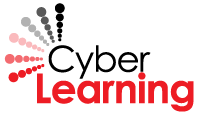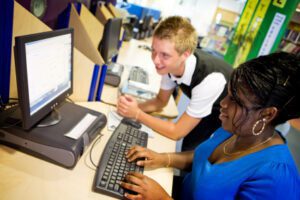On June 9 and 10, 2014, more than 100 investigators, innovators, researchers, and educators convened for a summit at the University of Wisconsin, Madison to identify and communicate major advances in learning with technology. Participants presented findings from diverse projects, yet a common message emerged from the summit: the importance of highlighting new images of what learning looks like.

The images of learning shared at the summit centered on students’ engagement in meaningful inquiry and knowledge creation, while using new tools that enable students to more intuitively and deeply express what they know and can do. The images also emphasized collaboration and conversation with both peers and mentors, and that student inquiry and learning is accelerated and sustained when students participate in supportive learning communities. While technology in learning is growing rapidly through the efforts of many communities, the cyberlearning research community demonstrated unique accomplishments in achieving this new image of learning in several ways:
- Through design-based research
- By incorporating modern learning theory
- By collecting rigorous data to inform improvement
- By building partnerships for impact
Further, the cyberlearning community showed unusual strength in approaches to learning that spanned and connected classroom-based, home-based, and community-based learning environments.
Opening presentations featured compelling images of how technology can support students’ engagement in inquiry and knowledge creation. For example, Dr. Ingmar Riedel-Kruse (Stanford University) showed how an undergraduate biology course could engage students in meaningful inquiry despite students’ lack of prior experience in setting up biology experiments. Dr. Riedel-Kruse demonstrated a robotic apparatus for conducting controlled experiments with real organisms from an internet browser. This apparatus allowed undergraduates to design their own experiments to explore patterns of growth and to collect data and images from the experiments on their laptops over the internet, from any place and at any time of day. This enabled students’ inquiry process to grow from curiosity about visual patterns to running an extended series of experiments and collecting quantitative data, while supporting newcomers to biology who didn’t have the requisite skills to set up biological experiments and measurement apparatus.

In a contrasting example that also features images of students engaging in authentic inquiry and knowledge creation, Dr. Jim Slotta (University of Toronto) showed how conventional classrooms could become places where students do field work. Strategically placed monitors in a reconfigured classroom revealed an imaginary, simulated infestation of bugs crawling behind the walls and under the floorboards of the classroom, and students were thrust into the challenging of understanding the insects’ behavior by making observations, developing conjectures, and testing hypotheses. In another example, the classroom became a rainforest in which a simulated natural disaster had taken place, and students had to make observations and collect data to uncover the cause. Dr. Slotta’s central advance was a technique for writing computer-controlled scripts that could immerse students in these experiences, and yet keep them moving towards key learning outcomes—thus relieving the teacher of the need to orchestrate the sequence of learning experiences in these complex, immersive simulations. This allowed the teacher to focus with the students on the content and process of learning science.
Another characteristic of the images of learning at the summit was how they involved new forms of student expression. In a simple, yet mind-blowing demonstration of augmented reality, Dr. Jodi Davenport (WestEd) showed how technology could enable playful, hands-on work to connect with conceptual scientific investigations. Dr. Davenport handed out Lego-like models of molecules that students could hold in their hands and manipulate into new shapes. A tablet computer with special image recognition software was able to recognize what the student was doing and instantly visualize hidden scientific phenomena and variables—heat, energy, chemical bonds, etc.—thus connecting students’ physical moves to scientific models.
In another example overlaying scientific ideas on a familiar substrate, Dr. Tapan Parikh (University of California, Berkeley) showed tools that allowed youth to represent data about their communities by overlaying photographs and symbolic representations on maps on their mobile devices (e.g. from Google Maps). Likewise, Dr. Deborah Fields (Utah State University) demonstrated crafts that incorporate technology. She shared student projects such as making bicycling clothing that could show turn signals and increase safety. Dr. Fields’ message was that expression of STEM knowledge and skill could be grounded in hands-on projects with fabric, wood, and other materials—and not just what students do on paper or on computers. These are but a few of the exciting demonstrations given at the summit.
Although some people foresee technology as taking over human teaching roles, such as tutoring students or making instructional decisions, several of the strongest technological advances at the summit emphasized how technology could augment and complement the roles of people. In one example, Dr. Carolyn Rosé (Carnegie Mellon University) examined how students collaborate in online learning environments via discussion boards. She showed an innovative technology that could analyze the discussion and intervene as an additional discussion partner. Scholars have found that deep learning is fostered by when teachers and students engage in “accountable talk”. Dr. Rosé’s computational agents could join a conversation to bolster the human participants’ engagement in the routines of accountable talk, such as prompting students to ask each other to explain (and not just assert) ideas.

In another example, Dr. Janice Gobert (Worcester Polytechnic Institute) showed how a simulated science lab could give students useful feedback not only on multiple choice questions about simple facts, but also about the process of carrying out a scientific inquiry—and this feedback could help students and teachers focus not only on right answers but more importantly on how scientists conduct valid investigations.
In a third example, Dr. Sidney D’Mello demonstrated facial recognition technology that could detect when students were confused, frustrated, or bored—and the startling fact that the image recognition technology was more accurate in determining these emotions than typical teachers. Whereas the term “cyberlearning” might sound cold and robotic, Dr. D’Mello highlighted how cyberlearning is actually moving to richly engage with student emotions, and the relationships among emotion and reasoning—for example, that temporary state of confusion can be productive for students’ learning, but not if the confusion shifts into frustration and disengagement. Dr. D’Mello offered that the ability to recognize whether students were productively confused or unhappily frustrated by might help teachers and students better regulate learning experiences.
Participants at the summit also brought many examples of playful learning environments, such as games. However, when people think of video games they often imagine children engaged in solitary, isolated activity. In contrast, a particularly strong consonance among presentations at the summit was on the importance of collaboration and community for learning outcomes in playful environments.
For example, Dr. Nichole Pinkard (DePaul University) shared work from the Cities of Learning program, a summer program in Chicago (and soon, many other cities) that engages youth in a web of related neighborhood activities to increase their participation in STEM activities and build their personal identities as STEM learners. Dr. Pinkard explained how the thoughtful design of multiple opportunities for learning in neighborhoods and communities along with recruitment of different types of mentors and adult leaders led to positive experience for youth as they played games and engaged in playful activities. Here, STEM learning was situated not as a solitary game, but as a social gaming challenge in youths’ neighborhoods.
Dr. Leilah Lyons (University of Illinois, Chicago and New York Hall of Science) highlighted how well-designed tools can foster a particularly productive form of collaborative learning in which students have tools aggregate what they are learning, potentially on different aspects of a shared phenomena or problem.
Dr. Yasmin Kafai (University of Pennsylvania) emphatically demonstrated how programming (an activity which is strongly connected with images of solitary activity) engages learners more strongly when understood and contextualized as a community activity which involves more than writing code—how online youth communities where students tell stories, build games, and make animations can foster learning to code.

As the summit wrapped up, participants reflected on the challenge of achieving large-scale impacts from cyberlearning investigations. Some thought it could take 10 to 20 years until these new images of learning were widely deployed in society and a similar length of time for the necessary technologies to mature and become widespread. Others saw opportunities to deploy cyberlearning advances more immediately, potentially in the context of existing products or classroom practices. Some suggested open source as a means to make technical advances available more broadly, while others emphasized the participation of cyberlearning leaders in start-up companies or as consultants to established companies.
Importantly, representatives from both large and small commercial and nonprofit publishers attended the meeting. Michael Jay of Educational Systemics offered a key insight. Mr. Jay said the overriding challenge was overcoming cultural differences between research communities and practitioner communities, and between research communities and entrepreneurial communities—differences that make communicating about advances and working together difficult. There was broad agreement that it was important to keep exploring and understanding these differences, and to find practical, immediate steps that would enable the cyberlearning community to engage with like-minded, yet complementary partners to achieve greater impacts.
More information about the cyberlearning summit and other activities and accomplishments can be found at the http://circlcenter.org web site. Video recordings of many of the key talks are available at this site and on YouTube.
The Cyberlearning Summit was hosted by the Center for Innovative Research in Cyberlearning (CIRCL), based at SRI International in collaboration with Educational Development Center (EDC) and NORC. Funding was provided by the National Science Foundation. Dr. Sherry Hsi (Lawrence Hall of Science) served as program chair, assisted by a diverse program committee, as well as a logistics team headed by Sarita Pillai at EDC.
This material is based upon work supported by the National Science Foundation under Grant Numbers IIS-1233722 and IIS-1441631. Any opinions, findings, and conclusions or recommendations expressed in this material are those of the author(s) and do not necessarily reflect the views of the National Science Foundation.


